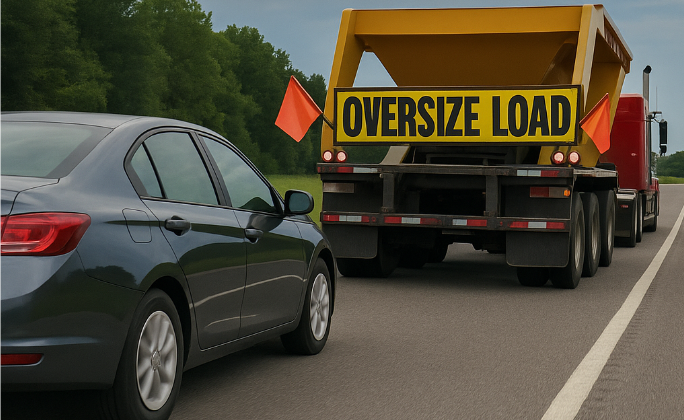If you’ve ever been stuck behind a slow-moving oversized truck on a narrow highway, the question has probably crossed your mind: can you pass an oversized load—legally, safely, and without risking a ticket or worse, a crash?
The answer isn’t as straightforward as a yes or no. In fact, it depends on a wide spectrum of factors—oversize load regulations by state, road design, escort vehicle behavior, weather, and even your own judgment as a motorist.
Reliable Permit Solutions, a leader in oversize overweight permit, understands that permitting is only one piece of the puzzle. The bigger challenge lies in real-world, moment-to-moment safety—especially when everyday drivers interact with permitted loads.
Laws Are Not Universal: State-by-State Passing Regulations
Each state answers the question can you pass an oversized load slightly differently. Some states allow passing only if there’s a dashed centerline and no escort vehicle is actively blocking the lane. Others prohibit any passing maneuver regardless of road conditions if the load exceeds a certain width or if visibility is compromised.
For instance, in California and Arizona, passing is discouraged when escort vehicles are using “DO NOT PASS” paddles or if the load is navigating a curve or grade. In Texas, signage on escort vehicles is legally binding—ignoring it could lead to fines or even reckless driving charges.
Bottom line? Oversized load passing regulations vary widely, and knowing the local laws is critical whether you’re the motorist or the hauler.
Escort Vehicles: Mobile Traffic Controllers in Disguise
Escort vehicles—also known as pilot cars—aren’t just for show. They’re trained, regulated, and in many cases, legally empowered to control passing behavior. When they signal “Do Not Pass,” that isn’t a suggestion.
One of the most misunderstood aspects of can you pass an oversized load is the role of escort vehicles. Their presence, signals, and behavior can override normal road passing rules. If they’re straddling the lane or swerving gently to block you, it’s for a reason: the load might be navigating a tight bend or taking up more of the road than you realize. These movements are often dictated by strict wide load requirements, which are designed to ensure safety for both the transport crew and surrounding drivers.
Road Types Matter More Than You Think
You’re more likely to be allowed to pass on a multi-lane divided highway than on a rural two-lane road. That’s because safe overtaking of oversized transport depends heavily on road configuration.
Passing on two-lane highways is typically restricted because oversized loads often use both lanes to safely clear curves, hills, or obstructions. Even if it looks safe, it might not be.
If the route has been pre-approved by permitting agencies, such as those coordinated through Reliable Permit Solutions, it may include temporary passing zones or designated pull-outs, but you won’t know unless you’re paying attention to signage and escort behavior.
Visibility, Weather & Traffic Density: The Invisible Rules
Legally, there may be nothing preventing you from passing. But should you? Fog, rain, blind curves, sun glare, or high traffic density can instantly shift the answer to Can you pass an oversized load from “maybe” to “absolutely not.”
Remember, oversize loads often have limited maneuverability and longer stopping distances. The safety buffer needed is far greater than with regular vehicles. Just because your state allows passing doesn’t mean it’s safe to execute in real-time traffic.
Signs, Lights, and Signals: Read the Road’s Language
Oversize transports typically carry banners, lights, and sometimes even real-time signage on the back of their rigs. These signs might read “Wide Load,” “Oversize Load,” or have flashing arrows to indicate lane usage. Escort vehicles may display digital message boards or use paddles.
Learning to interpret these cues is vital. If you’re asking yourself, can you pass an oversized load, the answer may be staring you in the face—in LED lights or a paddle sign.
The Cost of Getting It Wrong
Passing when it’s not legal or safe doesn’t just put you and others at risk—it can get you fined, sued, or criminally charged. Many states now treat improper passing of an oversize load as a moving violation, or worse, reckless endangerment.
Even worse, causing an accident with an oversize transport could trigger liability for both parties, even if you’re just a commuter caught in the wrong lane at the wrong time.
The Role of Technology: Smarter Passing Ahead
Modern permitting services like Reliable Permit Solutions increasingly incorporate GPS-based escort tracking and digital route mapping that optimize not only the oversize vehicle’s journey but also the safety of those around it.
In the future, real-time updates on when and where you can pass an oversized load could be delivered straight to your navigation system. For now, awareness, courtesy, and education remain your best tools.
Best Practices for Drivers and Haulers Alike
For motorists: slow down, obey signage, and don’t assume it’s safe just because the road looks clear.
For haulers: make your signage obvious, coordinate clearly with escorts, and work with a professional oversize load permits provider like Reliable Permit Solutions to ensure routes are designed with public safety in mind.
So, Can You Pass an Oversized Load?
Legally—sometimes. Safely—only if a long checklist of conditions is met. Just because you can doesn’t mean you should. When in doubt, hang back, wait for the right moment, and trust the coordination between transport experts, escort drivers, and services like Reliable Permit Solutions, who ensure everyone, from hauler to highway commuter, gets home safely.

